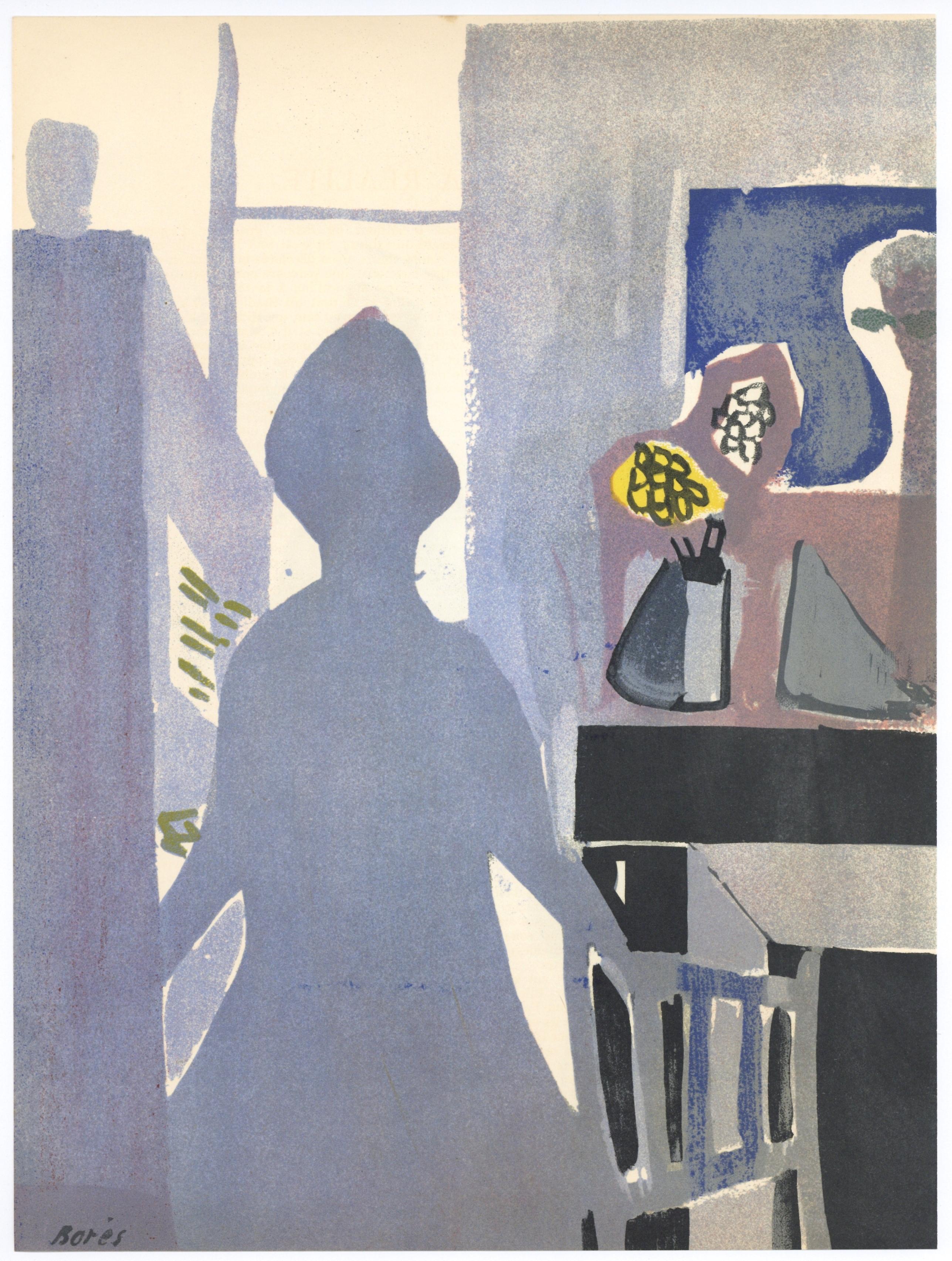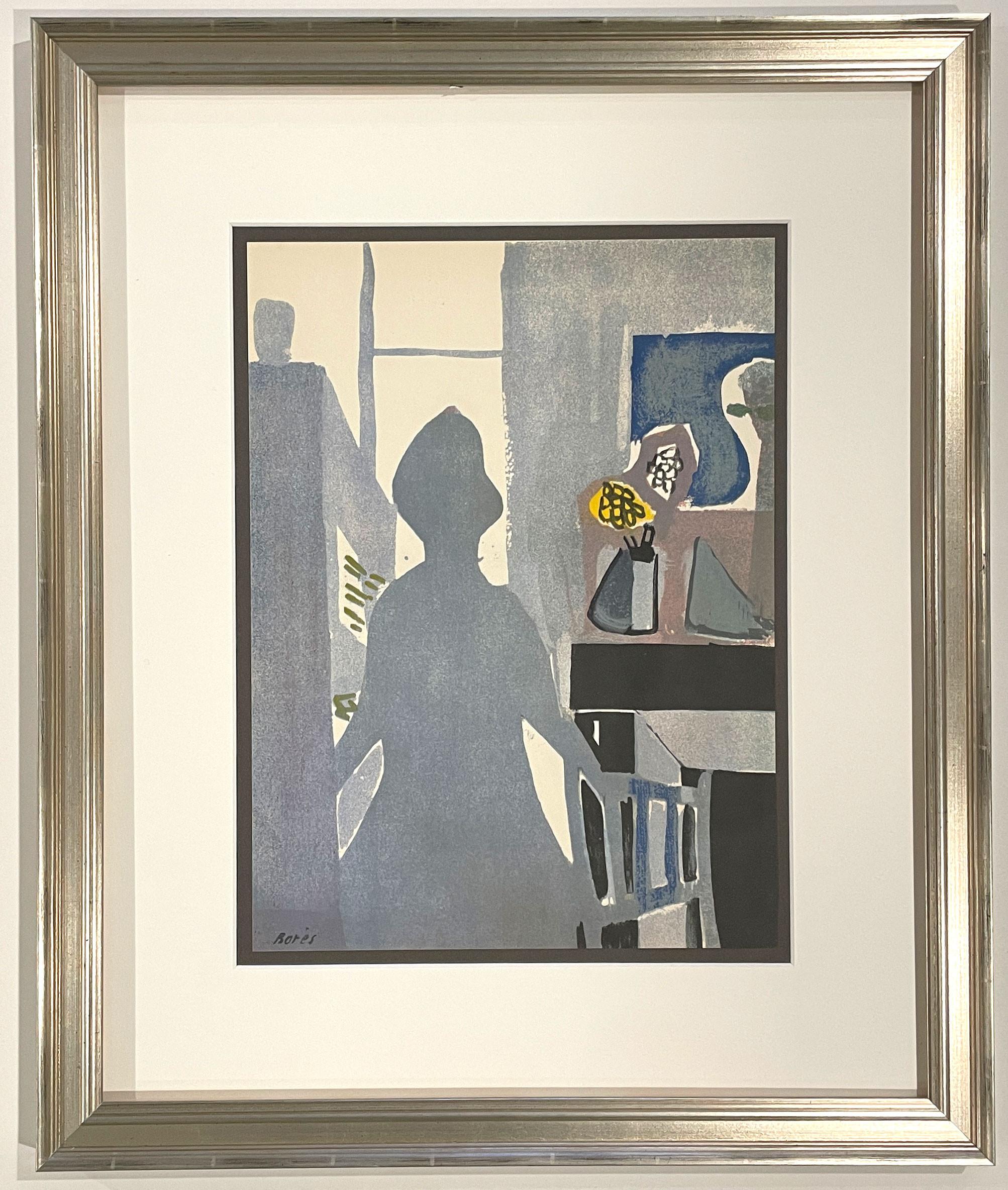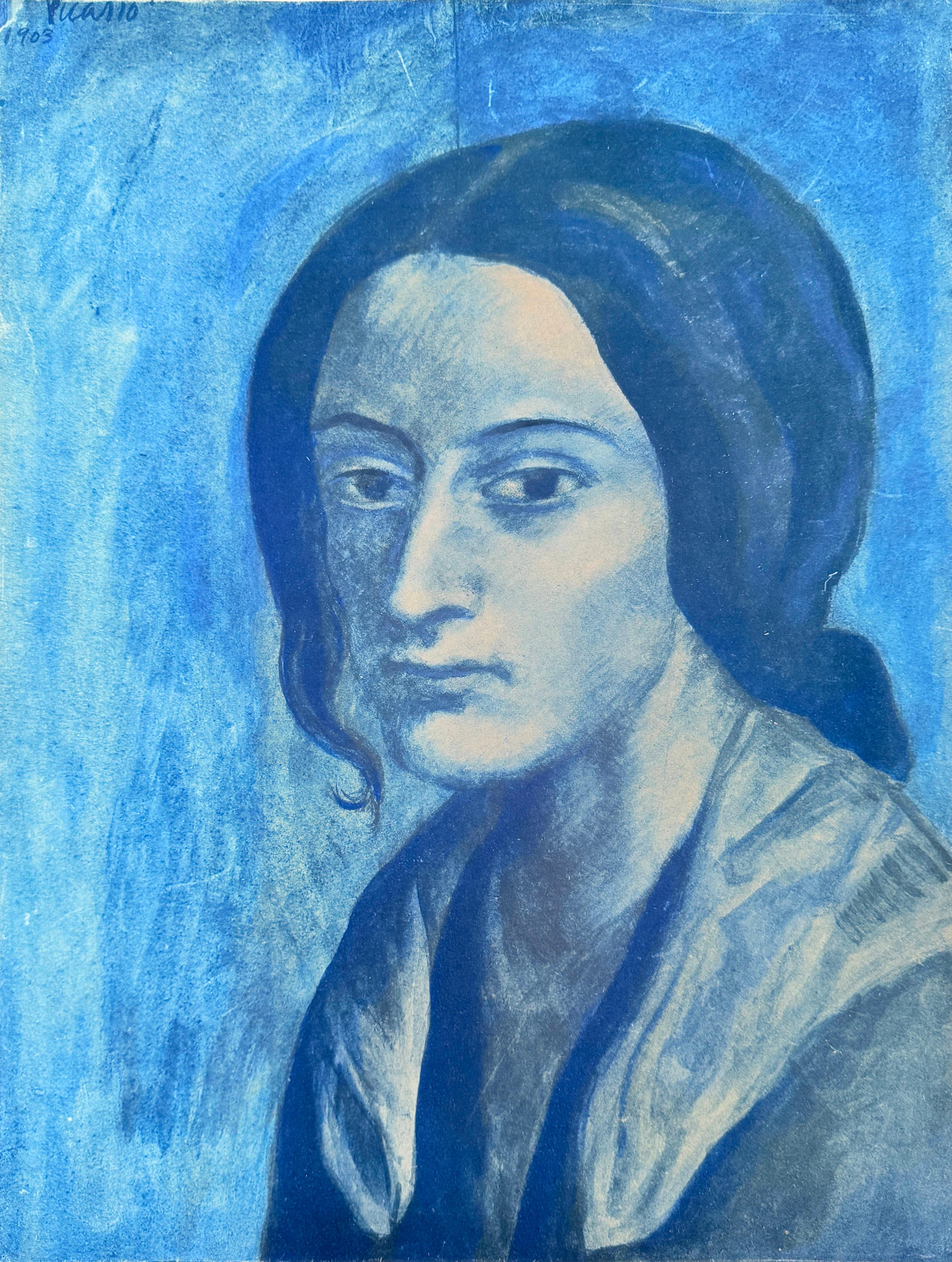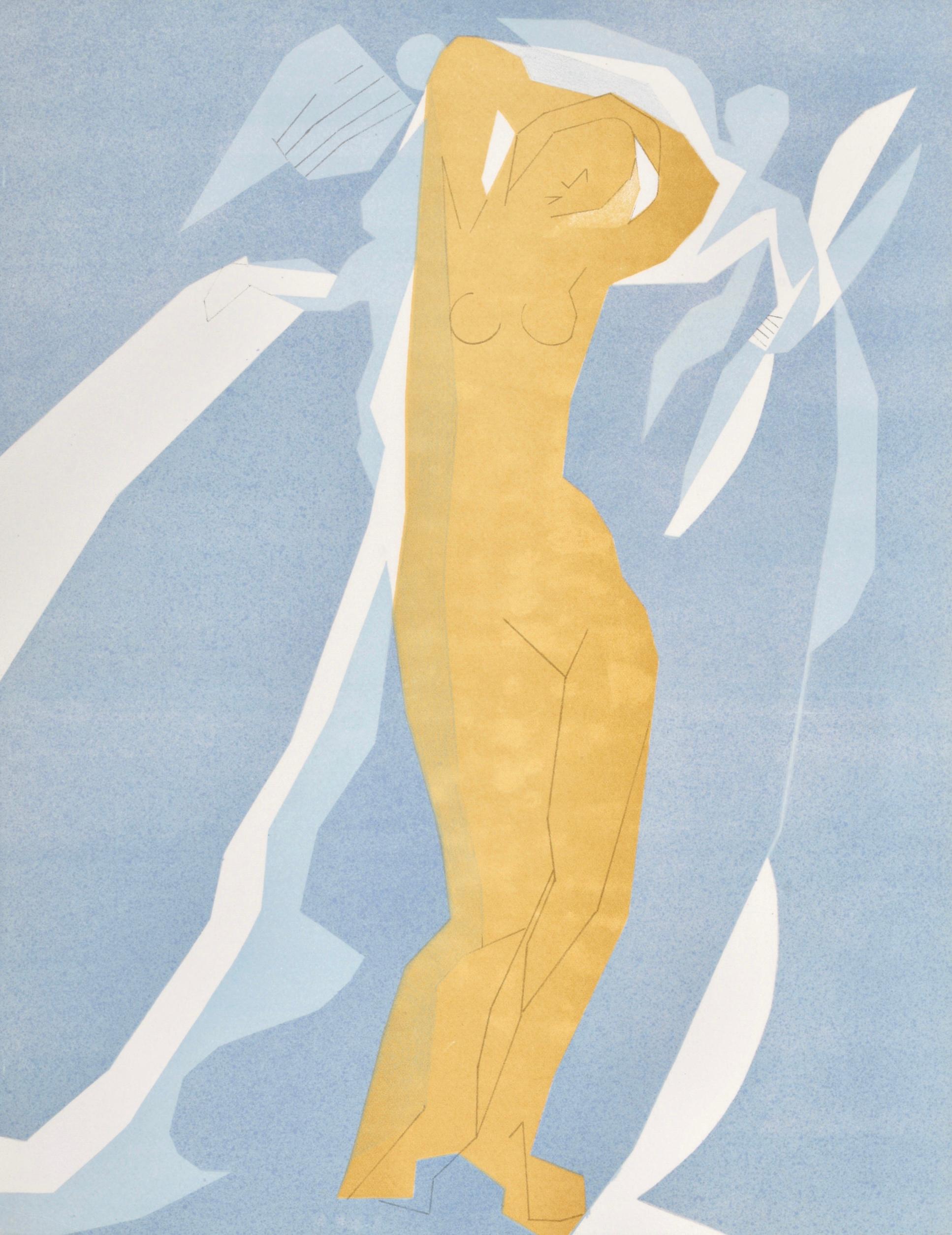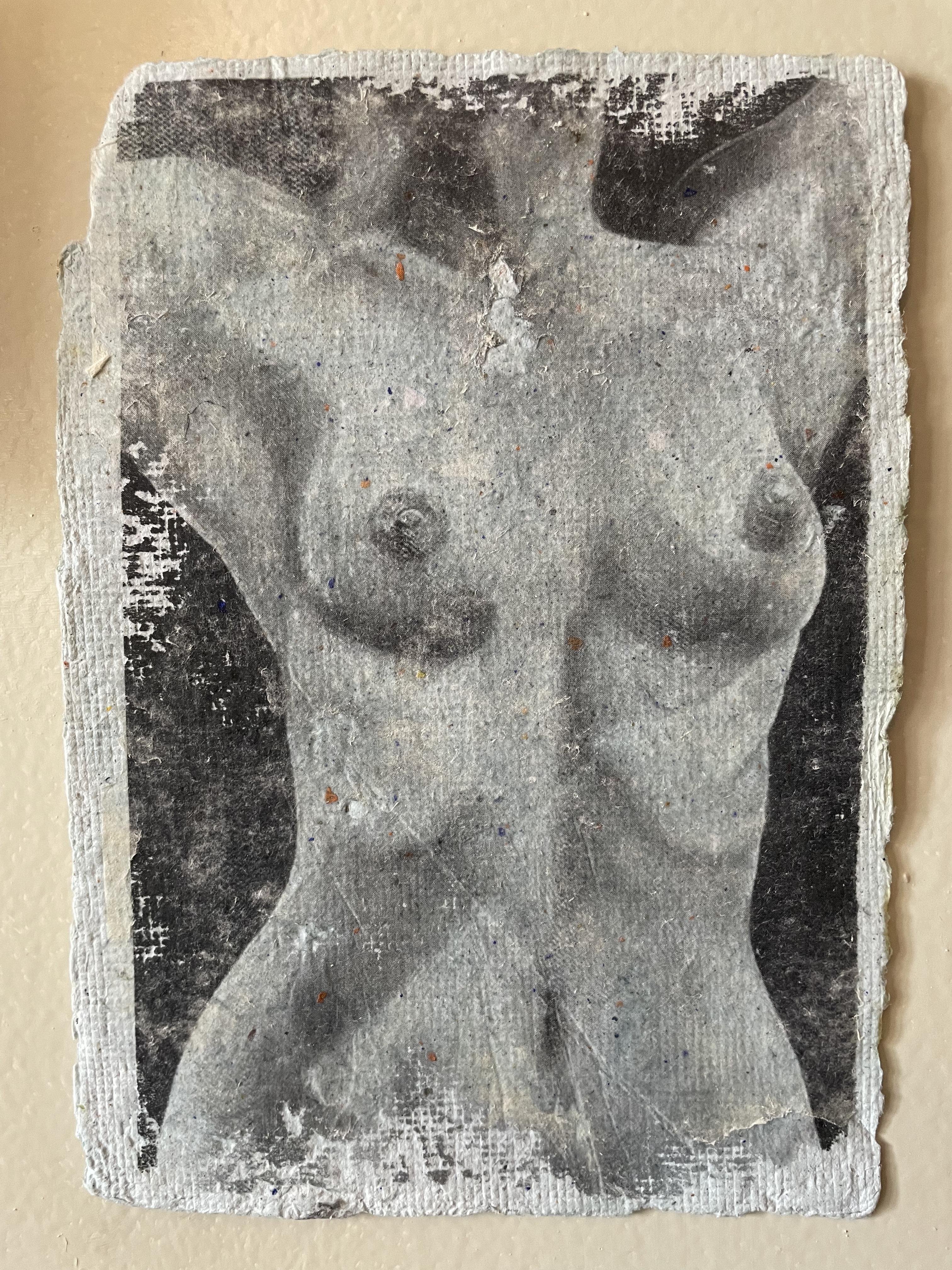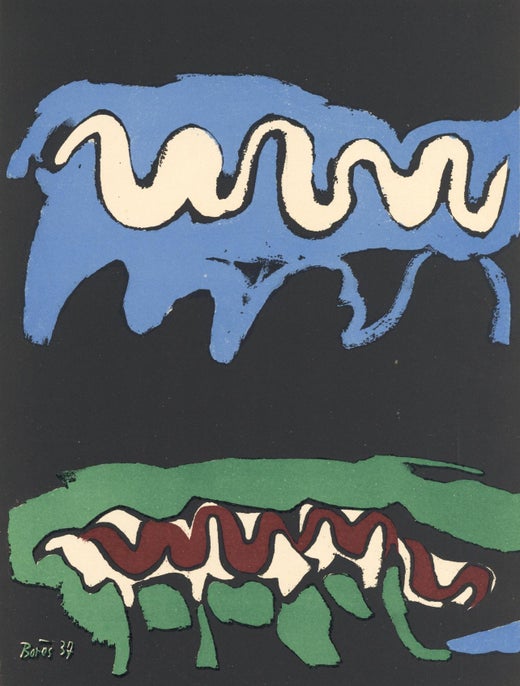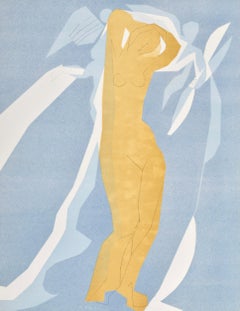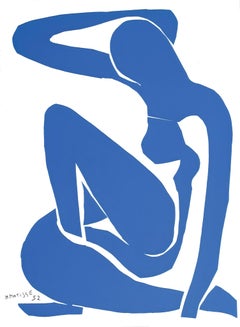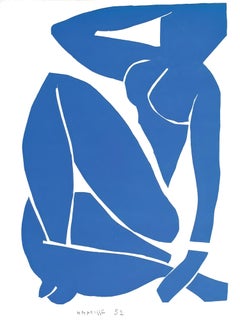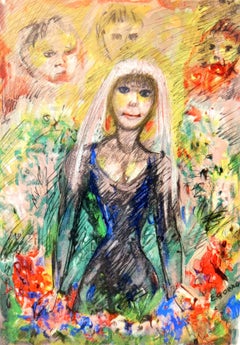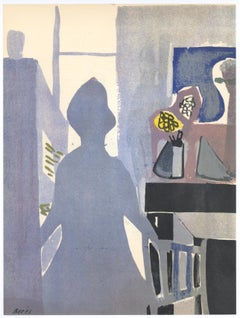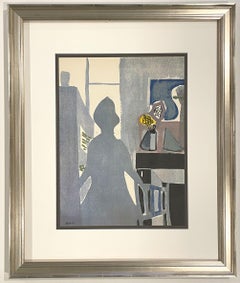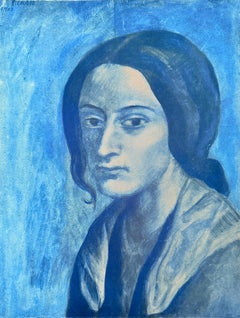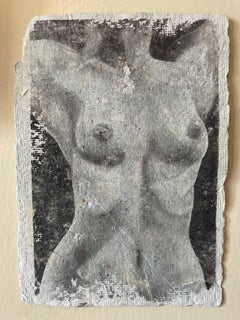Objekte ähnlich wie La Femme en Bleu, Verve: Revue Artistique et Littéraire
Möchten Sie mehr Bilder oder Videos?
Zusätzliche Bilder oder Videos von dem*der Anbieter*in anfordern
1 von 11
Francisco BoresLa Femme en Bleu, Verve: Revue Artistique et Littéraire1953
1953
624,46 €
780,58 €20 % Rabatt
Angaben zum Objekt
Lithographie auf Vélin des Papeteries du Marais Papier. Papierformat: 14 x 10,25 Zoll. Beschriftung: In der Platte signiert und nicht nummeriert, wie ausgegeben. Anmerkungen: Aus dem Album, Verve: Revue Artistique et Littéraire, Vol. VII, N° 27-28, 1953. Herausgegeben von Éditions de la revue Verve, Paris, unter der Leitung von Tériade, éditeur, Paris; gedruckt von Mourlot Frères, Paris, 15. Januar 1953, in einer Auflage von MM. Auszug aus dem Album (übersetzt aus dem Französischen): Diese Doppelausgabe von Verve wurde am 15. Januar 1953 von Draeger für die Typografie und den Tiefdruck und von Mourlot für die Lithografie zum Druck gebracht. Zusätzliche Anmerkungen: Auszug aus Poppy Sfakianaki, "La revue Verve (1937-60): Un tremplin pour la carrière de Tériade dans les éditions d'art", Journal of European Periodical Studies, 4.2 (Winter 2019), 70-89, 1937 lernte Tériade (1897-1983) David Smart (1892-1952), den amerikanischen Verleger des Magazins Esquire, kennen, der ihm anbot, an der Gründung der "schönsten Zeitschrift der Welt" mitzuarbeiten. Smart erkannte in Tériade nicht nur seine Fähigkeiten als Verleger und seine Kenntnisse der Kunstgeschichte, sondern auch sein berufliches Netzwerk und den Namen, den er sich in der Pariser Kunstwelt gemacht hatte - alles entscheidende Vorteile für ein Verlagshaus. Mit der kommerziellen Überzeugung, dass sich Schönheit "verkauft", wollte Smart das amerikanische Publikum ansprechen, das sich von der französischen Kunst, einschließlich der modernen Kunst, und dem Mythos des künstlerischen Lebens in Paris angezogen fühlte. Tériade seinerseits sah in der vorgeschlagenen Collaboration die Möglichkeit, sich auf dem amerikanischen Markt zu etablieren - einem starken Verbündeten der modernen Kunst in Frankreich. Éditions de la Revue Verve wurde im November 1937 gegründet, hauptsächlich von Smart finanziert und von Tériade geleitet. Verve: Revue Artistique et Littéraire war eine luxuriöse und ehrgeizige Kunstzeitschrift, die nicht nur auf Französisch, sondern in den ersten Jahren auch auf Englisch erschien und in Europa und den Vereinigten Staaten vertrieben wurde. Der Aufbau der Zeitschrift erinnerte an die französischen Kunstzeitschriften Cahiers d'art, Minotaure und Arts et métiers graphiques sowie an die amerikanische Kunstzeitschrift Coronet. Verve war der Konkurrenz jedoch aufgrund seiner reichhaltigen Ikonographie und der hohen Druckqualität überlegen. Ihr Preis schwankte vor dem Krieg zwischen 60 und 150 Franken (für Doppelnummern) und während des Krieges zwischen 120 und 350 Franken. Aufgrund ihres hohen Preises richtete sich die Zeitschrift vor allem an Kunsthändler, Sammler, Bibliophile und wohlhabende Kunstliebhaber. Die exquisite Ästhetik der Zeitschrift verdankt sich ihrem Chefredakteur Tériade, der eine Plattform für den Dialog zwischen Bild und Text, bildender Kunst und Literatur schaffen wollte. Der dominierende Faktor jeder Ausgabe bleibt die Ikonographie, die sich aus Reproduktionen von Werken moderner Künstler, die Tériade bewunderte, und "Meistern", hauptsächlich der französischen Tradition, zusammensetzt, neben Fotos und Miniaturen mittelalterlicher Handschriften. Tériade verwirklichte mit seiner Zeitschrift zweifellos eine 1934 geäußerte IDEA, wonach Bücher als "ideales Museum" oder als Ausstellung dienen, in der alle künstlerischen Meisterwerke versammelt sind, die Malraux später in Le Musée imaginaire (Genf: Skira, 1947) weiterentwickelte, von dem Teile in Verve erscheinen werden. Während des Zweiten Weltkriegs änderte sich die Periodizität der Zeitschrift, die nun unregelmäßig erscheint, und die behandelten Themen wurden weniger vielfältig. So waren die während des Krieges (sowie 1945 und 1946) erschienenen Ausgaben ausschließlich der Reproduktion mittelalterlicher Buchmalerei gewidmet. Die Sonderhefte der Nachkriegszeit schließlich stellen jeweils die jüngste Produktion eines modernen Malers vor. Nur die Nummern 8 (1940) und 27-28 (1952) bildeten eine Ausnahme mit einer abwechslungsreicheren Zusammenfassung. Die Aufnahme von Verve war positiv, wie mehrere lobende Presseartikel während der gesamten Laufzeit belegen. Der Erfolg der Zeitschrift, Tériades Leidenschaft für moderne Kunst und mittelalterliche Handschriften, seine Bewunderung für die Publikationen von Ambroise Vollard und Albert Skira sowie seine Kenntnis der bibliophilen Welt veranlassten ihn bald, seine redaktionelle Tätigkeit auszuweiten. Trotz der praktischen Schwierigkeiten, die der Krieg mit sich brachte, wurde 1943 sein erstes Künstlerbuch veröffentlicht, das von Georges Rouault geschrieben und illustriert wurde. Bis 1975 veröffentlichte Tériade Éditions de la Revue Verve neun Bücher von modernen Künstlern wie Henri Matisse, Pablo Picasso, Marc Chagall, Joan Miró, die vollständig von den Künstlern verfasst wurden (Text und Bilder); siebzehn von anerkannten modernen Künstlern illustrierte Bücher; ein Album mit Lithografien von Fernand Léger über Paris, zwei Fotoalben von Henri Cartier-Bresson, zwei Monografien über die Künstler André Beaudin und Francisco Borès, eine luxuriöse Serie von Reproduktionen mittelalterlicher Buchmalereien und eine Reihe von Mappen über die große französische Architektur. Letztlich zeigt die vergleichende Studie der Zeitschrift und der Ausgaben von Verve: Revue Artistique et Littéraire die Bedeutung der stillschweigenden Beziehungsdynamik, die sich aus den Beziehungen der Collaboration und des Austauschs von symbolischem Kapital ergibt, das auf gemeinsamen Wahrnehmungen und Interessen sowie auf Gefühlen der gegenseitigen Freundschaft und Wertschätzung von Akteuren in der Kunstwelt beruht, die eine visuelle und bibliophile Kultur teilen und so zum Erfolg der Zeitschrift und des Verlags beitragen.
FRANCISCO BORES (1898-1972) war eine wichtige Figur der europäischen Kunst des 20. Jahrhunderts. Jahrhunderts. Er war ein wichtiger Vertreter der zweiten Welle spanischer Künstler, die in den 1920er Jahren nach Paris kamen und zu denen auch Pablo Picasso, Ginés Parra, Pedro Flores und Antoni Clavé gehörten; in seinem Heimatland wurde er jedoch erst in den 1970er Jahren wirklich anerkannt, als Aspekte seines Werks, die nicht in den vorherrschenden Informalismus und Sozialrealismus passten, endlich geschätzt wurden. Der Stil von Bores wurde durch seinen engen Kontakt mit den größten Malern der ersten Avantgarde geprägt: Pablo Picasso und Henri Matisse. Er bewunderte ihre Art, Formen zu konstruieren, den Klassizismus und später die kubistische Explosion. Bores harmonisiert diese Einflüsse in seinem Werk und geht über sie hinaus. Seine Kunstwerke sind im Museo de Arte Contemporáneo in Madrid ausgestellt.
- Schöpfer*in:Francisco Bores (1989 - 1972, Spanisch)
- Entstehungsjahr:1953
- Maße:Höhe: 35,56 cm (14 in)Breite: 26,04 cm (10,25 in)
- Medium:
- Bewegung und Stil:
- Zeitalter:
- Zustand:
- Galeriestandort:Southampton, NY
- Referenznummer:1stDibs: LU1465216383682
Francisco Bores
Francisco Bores López (Madrid, 5. Mai 1898 - Paris, 10. Mai 1972) war ein spanischer Maler der sogenannten Neuen Schule von Paris. Seine künstlerische Ausbildung erhielt er sowohl in der Malereiakademie von Cecilio Pla, wo er Pancho Cossío, Manuel Ángeles Ortiz oder Joaquín Peinado kennenlernte, als auch in den literarischen Versammlungen des Ultraismus in Madrid. In dieser Zeit fertigte er Stiche und Holzschnitte für zahlreiche Zeitschriften wie Horizonte, Cruz y Raya, Index und Revista de Occidente an. Im Jahr 1922 nahm er an der Nationalen Ausstellung der Schönen Künste teil. Im Jahr 1925 nahm er an der ersten Ausstellung der Iberischen Künstlergesellschaft teil. Der geringe Erfolg dieser Ausstellung veranlasst ihn, nach Paris zu gehen. In dieser Stadt teilte er sich ein Atelier mit dem spanischen Maler Pancho Cossío und traf auch Picasso und Juan Gris. Im Jahr 1927 hatte er seine erste Einzelausstellung in Paris. Von diesem Moment an integriert sich Bores in das Pariser Künstlermilieu, in dem er praktisch sein ganzes Leben verbringen wird. Im Jahr 1928, seiner ersten Ausstellung in einer Galerie in den Vereinigten Staaten, stellte er 1930 erneut aus, und zwar im Rahmen einer Gruppenausstellung im Museum of Modern Art in New York. In den folgenden Jahren stellt er weiterhin in verschiedenen Pariser Galerien aus, darunter die Galerie Georges Petit, die Galerie Bernheim und die Galerie Vavin Raspail. Er nimmt auch an mehreren Gruppenausstellungen teil, darunter die Ausstellung zeitgenössischer spanischer Kunst im Museum Jeu de Paume in Paris, und illustriert Bücher und Kunstzeitschriften wie Minotauro. Verträge mit den Zwemmer Galleries in London und der Galerie Simon in Paris. Ausstellungen in den Vereinigten Staaten, in der Buchholz Gallery in New York. Den Zweiten Weltkrieg verbringt er in Saint Jean de Luz, wo er seine Freundschaft mit Matisse wieder aufnimmt. 1947 erwirbt der französische Staat zum ersten Mal ein Werk von Bores, 1949 erwirbt das Museum of Modern Art in New York seine Gemälde. Die Ausstellungstätigkeit wird in ganz Europa wieder aufgenommen: Frankreich, Deutschland, Dänemark, Italien. Seine Aufnahme in den Kreis der Maler der Galerie Louis Carré, die in jenen Jahren (1954) zu den renommiertesten in Paris und damit in der Welt gehörte, ist bemerkenswert. Sporadisch illustriert er weiterhin Bücher (fünf Linolschnitte "Der Schrei nach dem Tod von Ignacio Sánchez Mejias" von Federico García Lorca, Lithografien zur Illustration des Gesamtwerks von Albert Camus, das 1962 von der französischen Imprimerie nationale veröffentlicht wurde). 1969 stellte er in der Galerie Theo in Madrid aus, was seine Annäherung an die spanische Öffentlichkeit darstellte, die sein Werk praktisch nicht kannte, außer in Fachkreisen, wo es hingegen sehr geschätzt wurde. Im Jahr 1971 stellt er erneut in der Galerie Theo aus und stirbt 1972 in Paris. Der Kritiker Joaquín de la Puente weist im Werk von Bores auf mehrere Perioden hin: Erneuter Klassizismus (1923-1925)
Neokubismus (1925-1929)
Malerei-Obst (1929-1933)
Innenszenen (1934-1949)
Stil in Weiß (1949-1969)
Anbieterinformationen
4,9
Platin-Anbieter*in
Premium-Anbieter*innen mit einer Bewertung über 4,7 und 24 Stunden Reaktionszeit
Gründungsjahr 1978
1stDibs-Anbieter*in seit 2021
1.177 Verkäufe auf 1stDibs
Typische Antwortzeit: <1 Stunde
- VersandAngebot wird abgerufen …Versand von: Southampton, NY
- Rückgabebedingungen
Einige Inhalte dieser Seite wurden automatisch übersetzt. Daher kann 1stDibs nicht die Richtigkeit der Übersetzungen garantieren. Englisch ist die Standardsprache dieser Website.
Authentizitätsgarantie
Im unwahrscheinlichen Fall eines Problems mit der Echtheit eines Objekts kontaktieren Sie uns bitte innerhalb von 1 Jahr für eine volle Rückerstattung. DetailsGeld-Zurück-Garantie
Wenn Ihr Objekt nicht der Beschreibung entspricht, beim Transport beschädigt wurde oder nicht ankommt, kontaktieren Sie uns bitte innerhalb von 7 Tagen für eine vollständige Rückerstattung. DetailsStornierung innerhalb von 24 Stunden
Sie können Ihren Kauf jederzeit innerhalb von 24 Stunden stornieren, ohne jegliche Gründe dafür angeben zu müssen.Geprüfte Anbieter*innen
Unsere Anbieter*innen unterliegen strengen Dienstleistungs- und Qualitätsstandards, wodurch wir die Seriosität unserer Angebote gewährleisten können.Preisgarantie
Wenn Sie feststellen, dass ein*e Anbieter*in dasselbe Objekt anderswo zu einem niedrigeren Preis anbietet, werden wir den Preis entsprechend anpassen.Zuverlässige weltweite Lieferung
Unsere erstklassigen Versandunternehmen bieten spezielle Versandoptionen weltweit, einschließlich individueller Lieferung.Mehr von diesem*dieser Anbieter*in
Alle anzeigenNu de femme en jaune et bleu, Regards sur Paris, André Beaudin
Von Andre Beaudin
Lithographie auf Vélin d'Arches Papier. Aufschrift: unsigniert und nicht nummeriert, wie ausgegeben. Guter Zustand. Anmerkungen: aus dem Folio, Regards sur Paris, 1963. Herausgegeben...
Kategorie
1960er, Moderne, Landschaftsdrucke
Materialien
Lithografie
903 € Angebotspreis
20 % Rabatt
Kostenloser Versand
Matisse, Nu Bleu VI (Duthuit 139), Verve: Revue Artistique (nach)
Von Henri Matisse
Lithographie auf Vélin du Marais Papier. Beschriftung: Unsigniert und nicht nummeriert, wie ausgegeben. Guter Zustand. Anmerkungen: Aus dem Band, Verve: Revue Artistique et Littérair...
Kategorie
1950er, Moderne, Landschaftsdrucke
Materialien
Lithografie
1.252 € Angebotspreis
20 % Rabatt
Kostenloser Versand
Matisse, Nu Bleu IX (Duthuit 139), Verve: Revue Artistique (nach)
Von Henri Matisse
Lithographie auf Vélin du Marais Papier. Beschriftung: Unsigniert und nicht nummeriert, wie ausgegeben. Guter Zustand. Anmerkungen: Aus dem Band, Verve: Revue Artistique et Littérair...
Kategorie
1950er, Moderne, Landschaftsdrucke
Materialien
Lithografie
La mariée, Vingt fables de La fontaine, Edouard Goerg
Von Edouard Goerg
Holzschnitt auf Vélin d'Arches-Papier. Beschriftung: in der Platte signiert und nicht nummeriert, wie ausgegeben. Guter Zustand. Anmerkungen: aus dem Folianten, Vingt fables de La Fo...
Kategorie
1960er, Moderne, Landschaftsdrucke
Materialien
Holzschnitt
624 € Angebotspreis
20 % Rabatt
Kostenloser Versand
Matisse, Nu Bleu VII (Duthuit 139), Verve: Revue Artistique (nach)
Von Henri Matisse
Lithographie auf Vélin du Marais Papier. Beschriftung: Unsigniert und nicht nummeriert, wie ausgegeben. Guter Zustand. Anmerkungen: Aus dem Band, Verve: Revue Artistique et Littérair...
Kategorie
1950er, Moderne, Landschaftsdrucke
Materialien
Lithografie
833 € Angebotspreis
20 % Rabatt
Kostenloser Versand
Matisse, Nu Bleu I (Duthuit 139), Verve: Revue Artistique (nach)
Von Henri Matisse
Lithographie auf Vélin du Marais Papier. Beschriftung: Unsigniert und nicht nummeriert, wie ausgegeben. Guter Zustand. Anmerkungen: Aus dem Band, Verve: Revue Artistique et Littérair...
Kategorie
1950er, Moderne, Landschaftsdrucke
Materialien
Lithografie
833 € Angebotspreis
20 % Rabatt
Kostenloser Versand
Das könnte Ihnen auch gefallen
Originallithographie „La femme en bleu“
Von Francisco Bores
Medium: Original-Lithographie. Aus der seltenen Ausgabe von Verve (Band 7, Nummer 27-28), 1952 in Paris bei Teriade erschienen und von Mourlot gedruckt. Größe: 14 x 10 3/8 Zoll (353 ...
Kategorie
1950er, Druckgrafiken und Multiples
Materialien
Lithografie
La Femme En Bleu
Von Francisco Bores
Künstler: Francisco Bores
Medium: Lithographie
Titel: La Femme En Bleu
Mappe: Verve, Band VII, Nr. 27-28
Jahr: 1952
Auflage: 6000
Signiert: In der Platte signiert
Gerahmt Größe: 22" ...
Kategorie
1950er, Figurative Drucke
Materialien
Lithografie
Melancholisches Frauenporträt in Blau
Von Pablo Picasso
Pablo Picasso (1881-1973) - Bildnis einer blauen Frau (Portrait mélancolique d'une femme en bleu)
Pochoir von 1961.
Die Auflage: 442/500 mit Bleistift geschrieben.
Abmessungen des...
Kategorie
1960er, Moderne, Figurative Drucke
Materialien
Schablone
Femme auf Blau
Brittany Noriega
Femme auf Blau
Lasertransferdruck auf handgeschöpftem Papier
Jahr: 2021
Größe: 8,5x6 Zoll
Von Hand signiert
COA bereitgestellt
Ref.: 924802-1654
Tags: figurativ, Fi...
Kategorie
2010er, Moderne, Druckgrafiken und Multiples
Materialien
Büttenpapier, Laser
164 € Angebotspreis
40 % Rabatt
Lady On Blue, Blau
Von Kismine Varner
Lebhafte Radierung einer Frau auf blauem Hintergrund von der amerikanischen Künstlerin Kismine Varner, um 1990. Signiert unten rechts.
Originalkunstwerk auf Papier auf einem weiß...
Kategorie
1990er, Porträtdrucke
Materialien
Radierung
Blaue Frau am Collerette
Von Pablo Picasso
Aus einem anderen Blickwinkel betrachtet, zeigt Pablo Picassos Druck dieser Frau seine Vielseitigkeit als Künstler. Vor einem Hintergrund aus tiefem Pflaumenholz ist der schräg gestellte Porträtierte in einer weniger radikalen Form des Kubismus dargestellt als viele der anderen Porträts des Künstlers. Dennoch zeigt auch dieses Blatt das Verständnis und die Beherrschung der Perspektive durch den Künstler. Eine Lithographie aus der Nachlasssammlung Marina Picasso nach dem Gemälde "Femme a la Collerette Bleue" von Pablo Picasso. Das Originalgemälde wurde 1941 fertiggestellt. In den 1970er Jahren, nach Picassos Tod, autorisierte Marina Picasso, seine Enkelin, die Anfertigung dieser Lithografie durch Laurent Marcel Salinas, der zu Lebzeiten eng mit Picasso zusammenarbeitete. Die limitierte Auflage wurde 1982 von Marina Picasso in Zusammenarbeit mit Jackie Fine Arts fertiggestellt und veröffentlicht. Die Lithografie ist auf französischem Arches-Papier gedruckt, verso mit einem Tintenstempel des Nachlasses versehen und auf der Vorderseite von Marina Picasso handsigniert und nummeriert. Das Prägesiegel der Domäne befindet sich unten rechts und das Kotelett der Druckerei unten links.
Blaue Frau...
Kategorie
Ende des 20. Jahrhunderts, Kubismus, Porträtdrucke
Materialien
Lithografie
